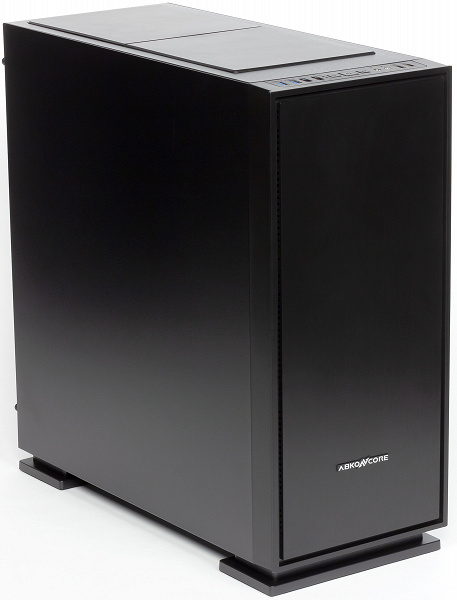
Today, for a change, we will consider a case without glass side walls, released under the South Korean trademark Abkoncore. This is quite an interesting and very voluminous Abkoncore Cronos Zero Noise case, which is preferred to be called the Abkoncore S700 on the site dedicated to Abkoncore brand products. The site provides a rather stingy description:
The Abkoncore Cronos Zero Noise Full-Tower Computer Case allows you to assemble a truly quiet PC, thanks to the use of thick steel and soundproofing materials.
The instructions are also not very detailed. At the time of writing the review, the retail price of the Abkoncore Cronos Zero Noise was about 7,500 rubles.
Note that the boxes of all three Abkoncore cases that came to us for testing do not have carrying handles, which is rather inconvenient. The boxes themselves are quite standard cardboard products with monochrome printing.
The design solution for the exterior of the case is quite successful here: minimalism, the absence of transparent elements and an exclusively black color in the design, and even with an empty case weight of about 11 kg. Definitely, such a case may well find its buyer. Obviously, the starting point for creating the exterior of the case (and not only it, to be honest) was the solutions from the Define series by the Swedish company Fractal Design, although the Silencio (Cooler Master) series of cases may also have served as a donor of ideas, if that’s possible to tell.

But most of all outside Abkoncore Cronos Zero Noise looks like a one and a half times enlarged Fractal Design Define C. In particular, the front panel is also stylized as brushed aluminum, although in both cases it is a fairly high-quality plastic. This is a very good move in the case of an inexpensive case, since the plastic will retain its marketable appearance for quite a long time, and there are almost no marks left on surfaces of this type.

Layout

The layout solutions of this model are determined by modern trends in hull building. In this case, the developers abandoned the 5.25″ device bay, and the usual 3.5″ device bay is located under the PSU cover near the front wall of the chassis, but it is present in a truncated form – only two disks. There are no seats for drives with external access in the case.
| Our measurements | frame | chassis |
|---|---|---|
| Length, mm | 513 | 461 |
| Width, mm | 225 | 215 |
| Height, mm | 518 | 492 |
| Weight, kg | 10.7 |
The case is a tower-type solution with a vertically placed E-ATX (up to 280 mm wide) or ATX (and smaller) format board and a horizontal power supply at the bottom of the case.
The case has a power supply cover. It closes the place where the power supply is installed from the side of the left wall, giving the internal appearance of the case neatness and completeness. True, for a case without a transparent left wall, this is not very important, but manufacturers have apparently already switched to a similar chassis design, so there are almost no new cases without a casing. Also, the casing plays the role of a kind of stiffening element, which provides additional fixation of the base for the system board from the bottom side.
Cooling system
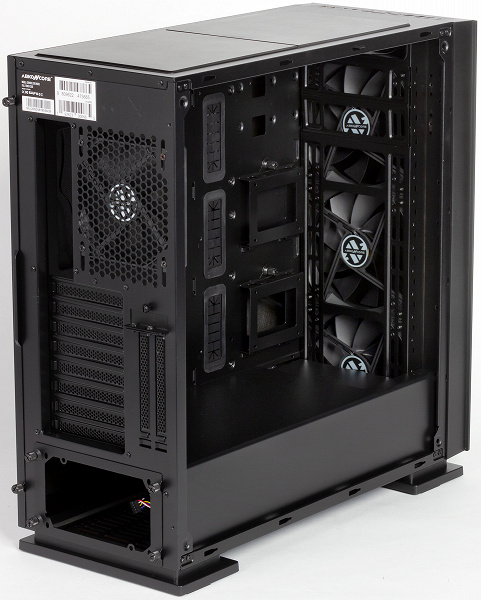
The case provides the ability to install fans of size 120 or 140 mm.
Seats for them are available in front, top and rear.
| Front | Above | Behind | On right | Left | |
|---|---|---|---|---|---|
| Seats for fans | 3×120/140 mm | 3×120 mm or 2×140 mm | 1×120 mm | No | No |
| Installed fans | 3×140 mm | No | 1×120 mm | No | No |
| Seats for radiators | 280/360 mm | 280/360 mm | 120 mm | No | No |
| Filter | No | No | No | No | No |
The case comes pre-installed with four fans: one 120mm in the back and three 140mm in the front. Interestingly, the front fans are mounted using long screws that are driven into holes in the chassis of the case, and not on self-tapping screws. The connector for the fans is a standard three-pin connector with control for changing the supply voltage. By default, all fans are connected to a standard controller based on a passive switch, powered by a peripheral connector (“molex”).
The controller has two fan control channels, three fans per channel, so that the fan park can be easily expanded if necessary. Each channel is controlled by a separate switch displayed on the control panel (on the top of the case). The switches have three positions, and in the central one the fans do not rotate (!). In L mode, they are supplied with 5 V, and in H – 12 V. The main drawback is that the connectors for connecting fans to the controller are designed only for the three-pin version. By default, the front fans are connected to one port on the controller, and the rear fans are connected to another.
Up to three radiators can be installed in the case, two of which can be 280 or 360 mm, and one 120 mm. By default, it suggests placing the radiator on top, where there are no regular fans. The ventilation holes in the front panel have such a small usable area that it is better to forget about installing a coolant system from this side right away, and the complete fans are installed here, rather, “for beauty”, and not to increase the cooling efficiency, since in such a case it is quite one fan in front of the drive cage is sufficient.
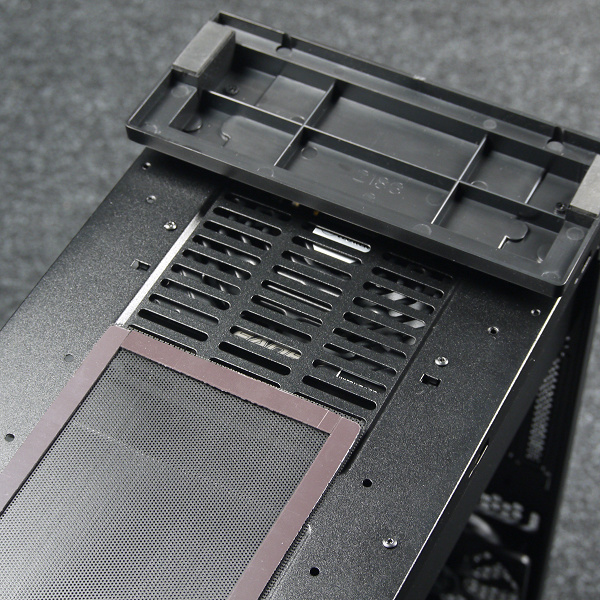
The filter under the power supply is quite conveniently removed and put in place thanks to the magnetic edging, but it can only be removed from the side – this cannot be done either in front or behind. It is made of a fairly large plastic mesh, and therefore most of the small dust particles will seep through it into the case and power supply. There are no other filters in the case.
Design
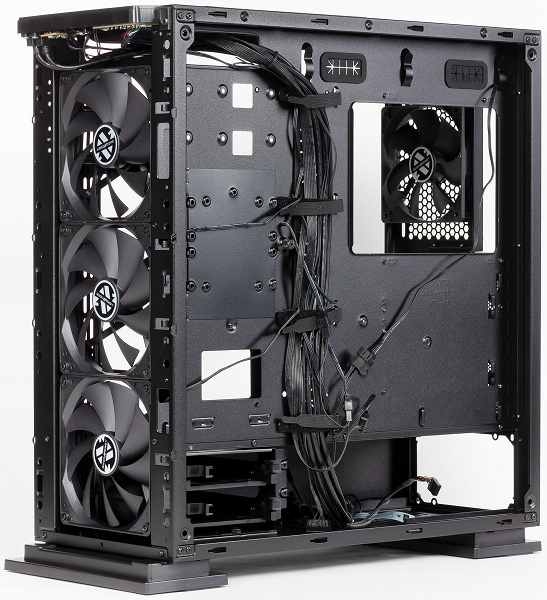
The case has a mass of about 11 kg and high structural rigidity, which is often an important parameter when choosing. Additional rigidity is provided by pasting all external panels, except for the bottom and rear, with vibration-isolating material based on synthetic fabric with special impregnation. On top of this material, covers over the ventilation holes are pasted over.
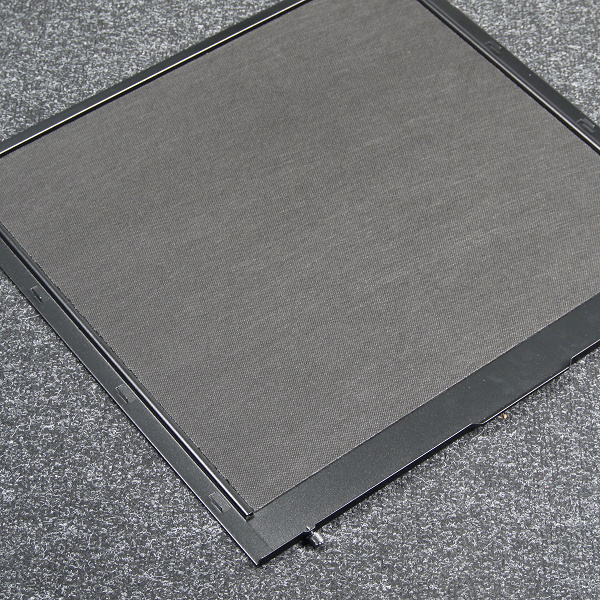
The side walls are a steel panel with a conventional tongue-and-groove system, as in budget cases. Their fastening is carried out by two all-metal screws with knurled head and anti-removable thread.

The top panel is made of steel, there is a ventilation grill, which is closed on top by two plastic covers with magnetic fastening. On the inside, the covers are pasted over with vibration-proof material.
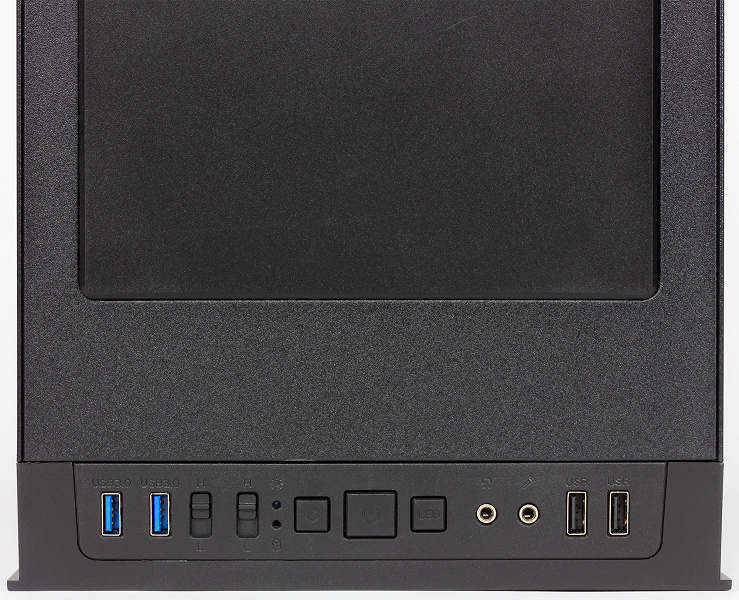
In front of the top panel there are controls and switching. They include 2 USB 3.0 ports, 2 USB 2.0 ports, standard microphone and headphone jacks, a power button, a reset button and a backlight control button (there is no backlight in this configuration, but the button is provided), as well as fan operation mode switches, connected to the body controller.

The entire front panel is made of plastic, which is colored in mass. The wires do not fit to the front panel itself, so it can be dismantled without any problems for cleaning or any other work. From the inside, the front panel is pasted over with vibration-proof material, but this is not done very carefully.

The case is based on two plastic supporting elements with small pads of rubber-like material.

Drives
| Maximum number of drives 3.5″ | 3 |
|---|---|
| Maximum number of drives 2.5″ | 5 |
| Number of drives in the front basket | 2 |
| Number of drives on the front side of the system board base | 4×2.5″ |
| Number of drives on the back of the motherboard base | 1×2.5/3.5″ |
Full-size hard drives are installed in a two-place cage designed for them. The basket in this case is mounted with a screw fastening, it can be removed or moved slightly closer to the rear wall of the chassis. The disks are installed in the basket through plastic sliding frames, the hard drive is attached to them using pins. Reliability of fastening rather high.
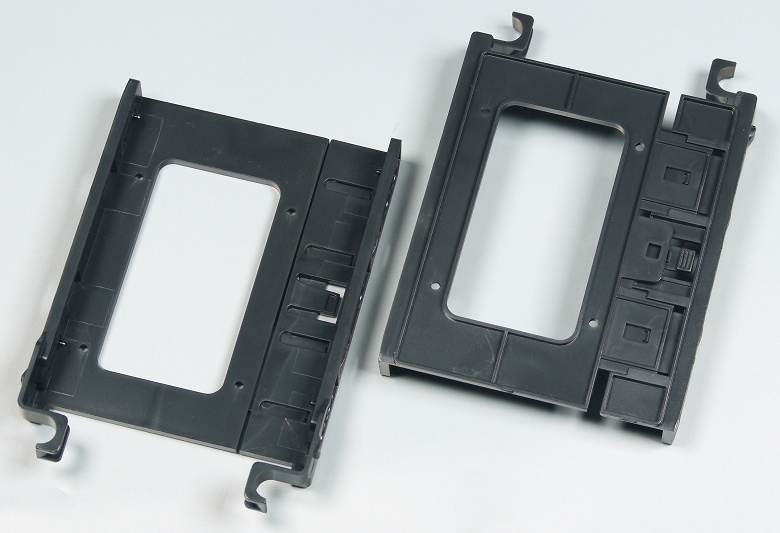
Note that these frames are universal, they can be used to install 2.5″ drives with drives mounted through the bottom.

On the front side of the motherboard base, there are two steel frames for 2.5″ drives. The frames are fastened by mounting holes that cling to the stampings. Containers are additionally fixed with knurled screws, drives are fixed with screws. There is a possibility of fixing disks both through the side holes and through the bottom, and given that the container is upside down, it is possible to install two disks on each container. True, this is an undocumented feature.
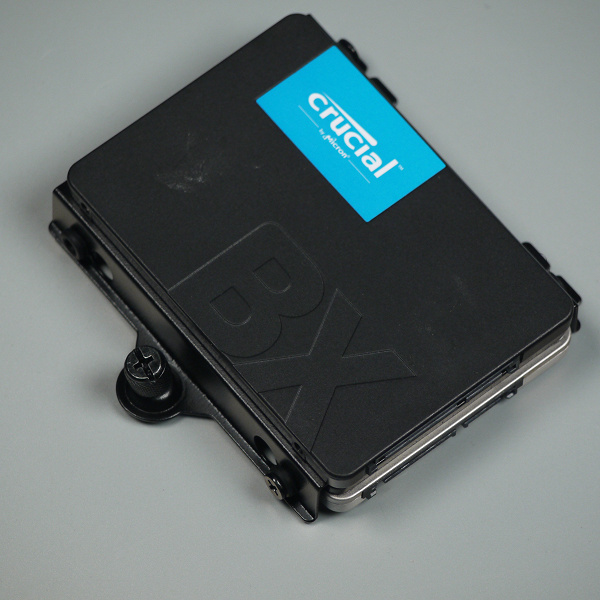
For fixing through the side holes, the kit includes elongated screws and rubber bushings.

If you install 2.5-inch hard drives in this way, you can count on vibration isolation.
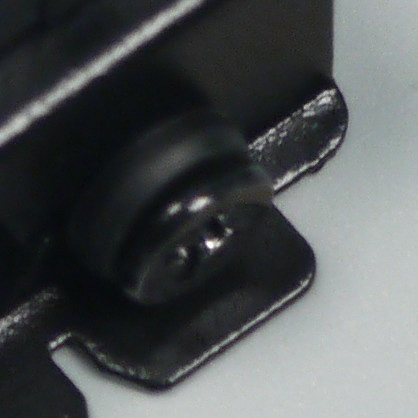
Another universal plate-shaped seat is provided on the reverse side of the motherboard base. The plate is fastened by mounting holes that cling to the stampings. The plate is additionally fixed with a knurled screw.

Here you can install any one drive: 2.5″ or 3.5″. The area of the plate allows you to install two 2.5″ drives, but the set of mounting holes does not provide for such an installation option. There is also a second place for a similar plate closer to the rear wall of the case, there are also stampings and an influx with threaded screw threads, but the mounting plate itself is not included.
The technical specifications on the manufacturer’s website indicate that the case can accommodate five 2.5″ or 3.5″ drives. Our calculations show that there are really five regular places for installing 2.5 ″ drives, you can also add a couple more drives with a “second layer”. But you can install 3.5″ drives only in the amount of three pieces. So formally, either 3×3.5″ + 2×2.5″ or 5×2.5″ can be installed in the case.
Of the advantages, it can be noted that the front basket, as well as the frames installed on the front side, are blown by standard fans.
Assembly of the system unit
Both side walls are attached with two thumbscrews and the usual slotted push-and-slide system. The walls are quite large, it is more convenient to put them on a horizontally lying body. In the case of a standing case, this procedure is more difficult to carry out.
The order in which the PC is assembled in the case does not really matter, since the components are separated and do not interfere with each other, but it is better to start by installing the power supply and wiring. The PSU is installed through the mounting plate at the back of the case and fixed with four screws. The case provides for the installation of power supplies of not only standard, but also larger sizes with a case length of up to 200 mm. The distance between the rear wall of the chassis and the basket in the standard position is about 300 mm, there is enough space for wiring.
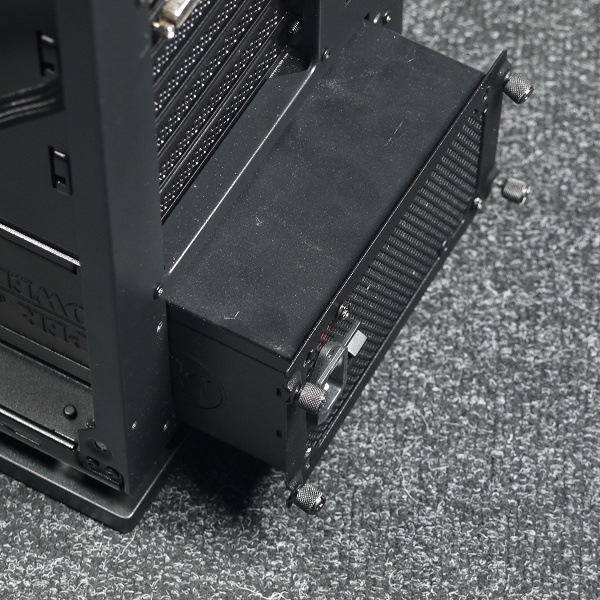
Some of the racks for mounting the motherboard are pre-set by the manufacturer. This was done, apparently, based on the dimensions of the narrowed ATX board, and to install a full-size board with a width of 244 mm, you will need to screw in a few more racks. There is room for a 280mm board, but the problem is that it will cover the mounting holes for wiring. So it is hardly reasonable to use an E-ATX board here.
| Some installation dimensions, mm | |
|---|---|
| Declared CPU cooler height | 170 |
| System board bay depth | 183 |
| Wiring Compartment Depth | thirty |
| Distance from the board to the fan mounting holes on the top of the chassis | 60 |
| Distance from the board to the top wall of the chassis | 60 |
| Main graphics card length | 305 |
| Additional graphics card length | 305 |
| Power supply length | 180 |
| Board Width | 280 |
In the case, according to the manufacturer, you can install a processor cooler up to 170 mm high. The distance from the motherboard base to the opposite wall is about 182mm.
The depth of the wiring compartment is about 20 mm at the rear wall. For mounting wires, loops are provided for fastening screeds or other similar products. Lobe membranes are installed in the mounting holes. It is not very convenient that there are no mounting holes for laying wires in the casing of the power supply – their presence would facilitate the laying of wires to the connectors on the bottom edge of the board.

Next, you can install the required expansion cards, including a video card that can reach a length of about 400 mm (according to the manufacturer). In reality, its maximum length is about 305 mm, since there are storage containers near the front wall of the chassis, which limit the length of the video card. However, this is quite enough for most typical solutions, since modern video cards rarely exceed 280 mm in length.

The system for fixing expansion cards here is the most common – fastening with screws from the inside of the case with individual fixation. All plugs for expansion cards are removable, fixed with one screw for a Phillips screwdriver.
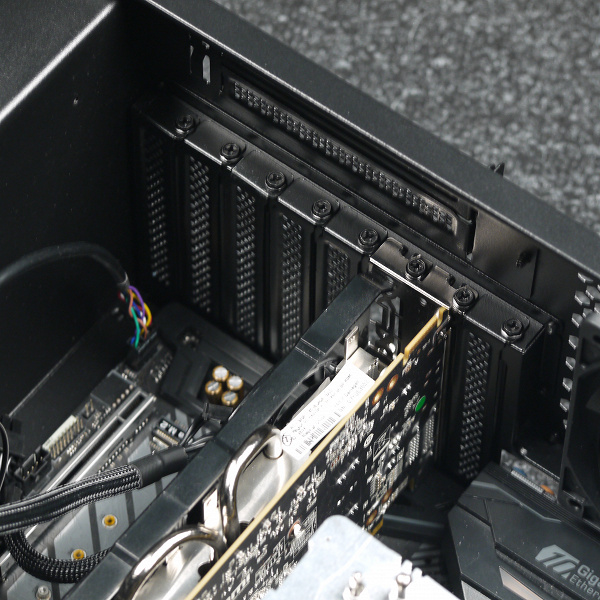
The ports and connectors of the front I / O panel are connected quite standardly: USB and audio – with monolithic multi-pin connectors, everything else – with two-pin and single-pin connectors.
Manipulating inside the case is quite convenient, although during the assembly process there is a certain saving on the execution of individual components and elements.
Acoustic ergonomics
| Mode | desktop placement | Floor placement |
|---|---|---|
| H | 30.5 dBA | 26.2 dBA |
| L | 21.2 dBA | 19.3 dBA |
The fans connected to the standard controller operate in the mode set using the switches on the control panel. In the L mode, the noise is at the minimum noticeable level, both on the floor and when the case is placed on the desktop. In H mode, the noise level can be described as reduced for a residential area during the daytime. In the intermediate position of the switch, the fans stop.
Results
Abkoncore Cronos Zero Noise is a budget solution. Of the features, we can note the presence of a vibration-isolating coating on the outer panels of the case, as well as a complete set of four fans connected to a two-channel controller. The functionality of the controller is quite modest, and it only supports fans with a three-pin connection, but it allows you to control their speed from the panel on the top of the case. Contrary to the practice of reducing the thickness and dimensions of steel elements, which is common for budget cases, these parameters are increased here. However, the Abkoncore Cronos Zero Noise cannot be called quite inexpensive either.
The equipment of the case is quite consistent with the cost: four USB ports (including two USB 3.0), four fans, which you should not count on for a long life. The performance quality is quite good. Of course, it is somewhat inferior to market leaders such as be quiet!, Fractal Design, NZXT, but cases of comparable sizes under these trademarks will cost more.
In general, the hero of our review looks quite utilitarian and well-tailored, especially from the outside. But he also has some shortcomings that will have to be overcome in different ways. The case is also frankly unsuccessful – for solving such dimensions, everything is relatively good here, taking into account its retail price. The option is not ideal, but it is quite working if you need a large case and want to save a little.




